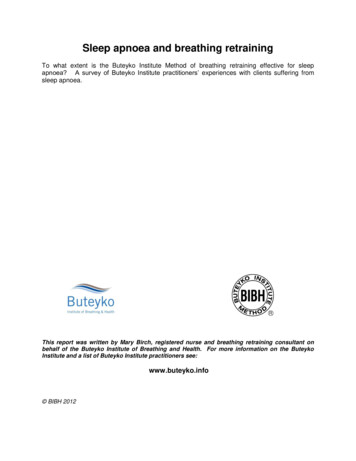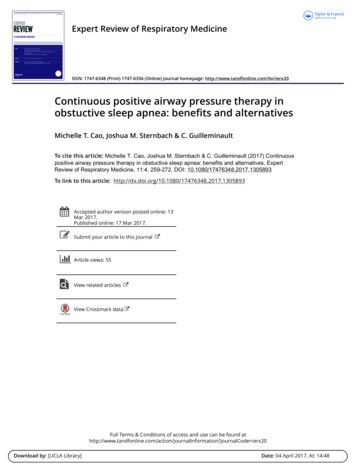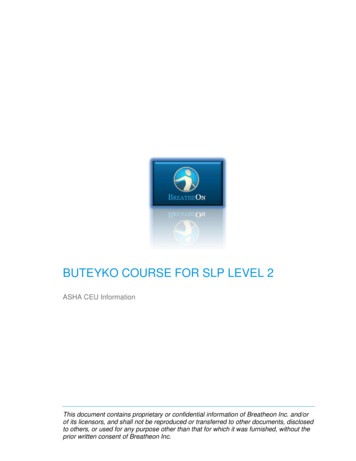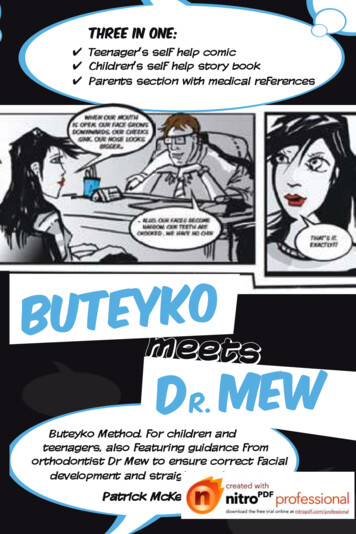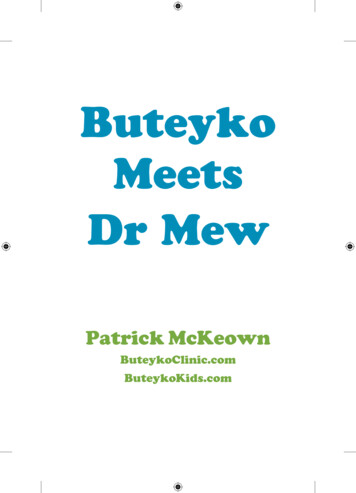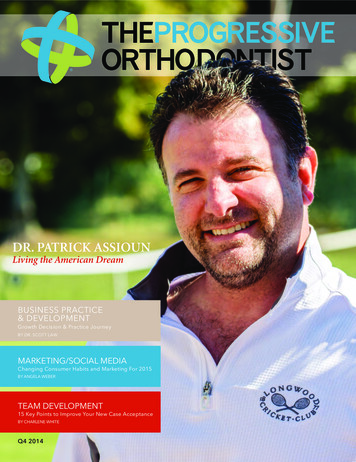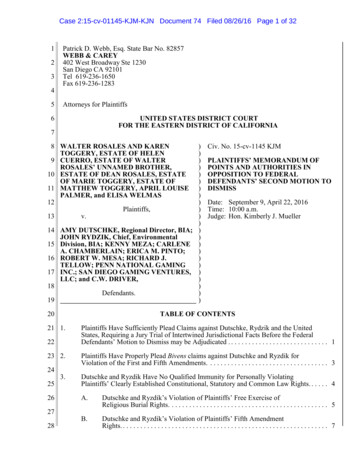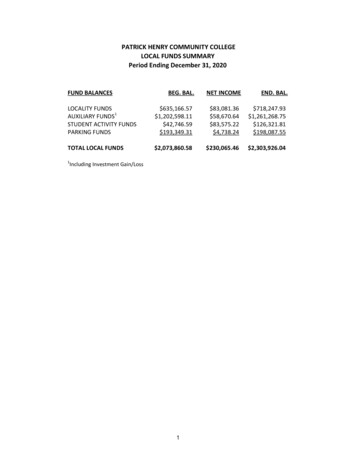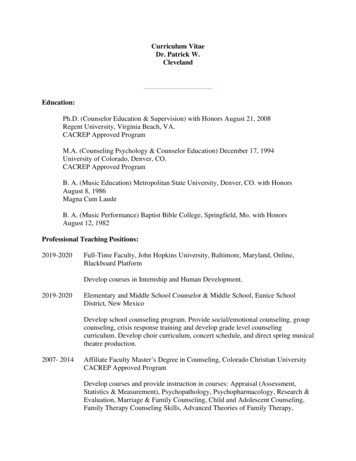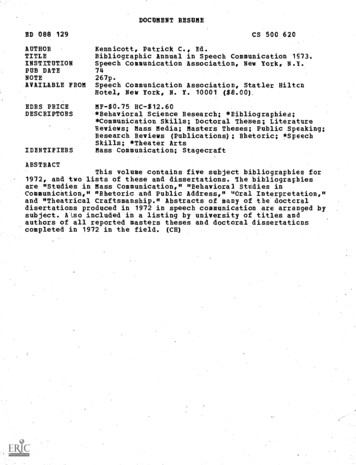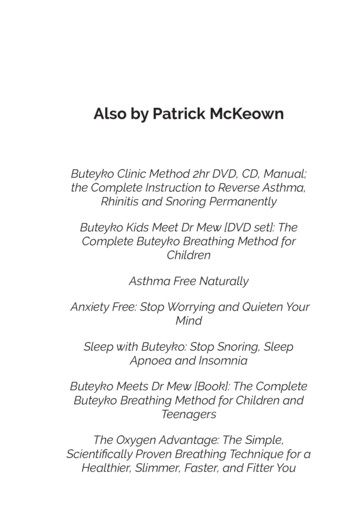
Transcription
Also by Patrick McKeownButeyko Clinic Method 2hr DVD, CD, Manual;the Complete Instruction to Reverse Asthma,Rhinitis and Snoring PermanentlyButeyko Kids Meet Dr Mew [DVD set]: TheComplete Buteyko Breathing Method forChildrenAsthma Free NaturallyAnxiety Free: Stop Worrying and Quieten YourMindSleep with Buteyko: Stop Snoring, SleepApnoea and InsomniaButeyko Meets Dr Mew [Book]: The CompleteButeyko Breathing Method for Children andTeenagersThe Oxygen Advantage: The Simple,Scientifically Proven Breathing Technique for aHealthier, Slimmer, Faster, and Fitter You
SHUTYOURMOUTHButeyko Clinic self helpmanual for high bloodpressure, fatigue, insomnia,chronic hyperventilation,asthma, snoring, andsleep apneaPATRICK G MCKEOWN
This edition was first published in 2015 Patrick McKeown 2012Web: www.ButeykoClinic.comEmail: info@buteykoclinic.comTel Intl: 00 353 91 756229The information contained in this book is not intended toserve as a replacement for professional medical advice.Any use of the information in this book is at the reader’sdiscretion. The author and the publisher specificallydisclaim any and all liability arising directly or indirectlyfrom the use or application of any information contained inthis book. A health care professional should be consultedregarding your specific situation.All rights reserved.No part of this publication may be copied, reproducedor transmitted in any form or by any means, withoutpermission in writing from the publishers. This book is soldsubject to the condition that it shall not, by way of trade orotherwise, be lent, re-sold or otherwise circulated withoutthe publishers prior consent, in any form of binding orcover other than that in which it is published and withoutsimilar condition including this condition, being imposedon the publisher.
ContentsChapter 1: Improve Oxygen Delivery withthe Buteyko Clinic MethodImportant: GuidelinesChapter 2: Buteyko Clinic Exercises72833Exercise 1: Decongest your nose easily40Exercise 2: Reduced Breathing:By relaxation;Attention on chest and tummy;Blocking one nostril;Cupping hands.46505555Exercise 3: Getting the most fromphysical exercise60Exercise 4: Breath holds during exercise64For Children and Teenagers69Exercise 5: Steps exercise for childrenand healthy adults73Exercise 6: Many Small Breath Holdsto stop anxiety, asthma or panic attack76Chapter 3: Lifestyle Factors79Getting a great night’s sleep79Foods that help, foods that hurt85Stress and breathing88Correct breathing during talking92
Chapter 4: Tailoring Buteyko to your needs95Programme for older person,low control pause or unwell95Programme for high blood pressure,panic attack, sleep apnea and anxiety97Programme for children and teenagers98Programme for busy adults101Appendix 1: International Buteyko Clinics107Appendix 2: Recommended Readingand Viewing108References109Diary of progress112Short summary of Buteyko Clinic Program121
CHAPTER ONEImprove OxygenDeliver y with theButeyko ClinicMethodreathing is an innate bodily function which most ofus take for granted – it only gets attention when itis not up to par. In addition to providing the body withoxygen, breathing also helps to regulate other vitalbodily functions, including biochemistry, the openingand closing of blood vessels and airways, and thestress response. In simple terms, poor breathing habitsdeprive literally disrupt biochemistry and deprive thebody of oxygen.BIf you were to observe and monitor the breathing of arandom group of people as they sit together in a room,noticeable differences would be evident. Some peoplemight breathe through their noses, while others mightbreathe through their mouth. Some will have gentle, slowand quiet breathing, while others will be taking muchlouder, larger breaths. Some people sigh habituallyevery few minutes, while others display a regularbreathing pattern. Some may use their diaphragm tobreathe into the tummy, while others breathe from theupper chest.Shut Your Mouth 7
Causes of chronichyperventilationSince breathing is a natural process and so vital to life, itbegs the question: why do we all breathe so differently?The causes of over-breathing vary from individual toindividual but are often due to environmental factors orlifestyle habits. Often, chronic hyperventilation is simplythe result of a lifelong habit of breathing through themouth. The following six factors are more common incountries of increasing modernisation and affluence:1. Diet: Over-eating increases breathing volumedue to the additional work that is required bythe body to process and digest the extra food.Eating processed foods puts further pressureon the digestive system since these foods aregenerally acidic, thereby altering the pH ofthe blood. As the body strives to correct thisimbalance, breathing increases in order toremove excess carbon dioxide (CO2).2. Talking: When we speak, we need to take inlarge breaths of air between each sentence.When we speak at length, over-breathingoccurs. People who work in retail, telesalesand teaching know all too well how tired andconstricted they can feel following a day’swork.3. Stress: When we are under stress, the ‘fightor flight’ response is activated. We react thesame way to modern day stresses as we did8Shut Your Mouth
when coming face to face with a predatorthousands of years ago. The difference is,when confronted by a physical danger, we hadthe option of fighting it or running away as fastas possible. In modern stressful situations, ourbreathing increases to prepare us for physicalactivity, but rarely do we perform the requiredphysical exercise to burn off the adrenaline.4. Sedentary lifestyle: When we move ourmuscles we generate the gas carbon dioxide,which helps to maintain body oxygenation.(explained in more detail later) A lack ofexercise results in lower production of CO2and a larger breathing volume. Fifty years agoit is estimated that we performed four hoursof physical exercise each day. Today, manypeople are lucky if they have half an hour ofexercise daily.5. Big breathing: The widely-spread belief thatit is beneficial to take big breaths is a majorcause of over-breathing in the Western world.Stress counsellors, gym instructors, sportscoaches, and media personnel who aremisinformed about correct breathing volumeoften encourage the practice of taking deepbreaths to bring more oxygen into the body.However, very often a deep breath is confusedwith a ‘big’ breath. A deep breath is what a babytakes naturally – a gentle, quiet inhalationusing the diaphragm, as demonstrated byrelaxed movements of the tummy. In contrast,Shut Your Mouth9
a big breath is often taken in loudly throughthe mouth and generally involves upper chestmovement, encouraging over-breathing.6. Higher temperatures: Modern homes andworkplaces are generally well-insulated butnot always well ventilated. Stuffy centralheated rooms make it difficult for our bodiesto regulate body temperature through theskin, therefore encouraging us to revert to theprimitive method of heavier breathing.When I talk about breathing, I am not just referring tothe amount of air that we breathe while under stress,during an asthma attack, panic attack or physicalexercise. There is no doubt that our breathing increasesduring these events, but they are usually temporary,only occupying a small amount of time in any day orweek. What I mean by breathing is the amount of airwe take in during everyday breathing, every minute,every hour of every day. Our everyday breathing habitsare of far greater consideration than the amount of airwe breathe during the short term, and it is this everydaybreathing that is gradually affected by our environmentand lifestyle.Incorrect breathing has a significant effect on theoxygenation of the body, causing constriction of theblood vessels and airways, and reducing oxygendelivery to the cells.10Shut Your Mouth
Depending on genetic predisposition, breathing moreair than what the body requires contributes to thefollowing:» High blood pressure» Stress» Anxiety» Depression» Sleep-disordered breathing (including snoringand sleep apnea)» Asthma» FatigueIf you suffer from any of these symptoms or generallyfeel lacking in energy, I strongly encourage you totake a look at the way you breathe. To make positivephysiological changes to your health, it’s importantto re-train your breathing habits – and I’m not talkingabout the ‘big breaths’ often espoused in Westernyoga, pilates, physiotherapy and other commonrelaxation techniques – in fact, I am talking aboutdoing the opposite.All about healthy breathingHealthy people breathe gently, quietly, calmly, andeffortlessly with a natural pause on the exhale. Eachbreath is taken in and out through the nose, even duringlight physical exercise such as walking. There shouldShut Your Mouth11
be no feeling of breathlessness during rest – if you arebreathing in a healthy manner, you should not even beaware of your breath.On the opposite end of the spectrum, poor breathinghabits create noticeable breathing. Unhealthy breathersoften use their mouths to take in air, breathing from theupper chest with large, obvious breaths. They probablysnore at night and their regular breathing may beinterspersed with sighs. Breathlessness, wheezing, orchest-tightness may also be experienced during rest.Despite taking a greater amount of air into the bodythan necessary, over-breathers still often feel that theyare not getting enough. For many people who habituallyover-breathe, breathing volume can be as much as twoto three times that of a normal individual.A worthwhile exercise at this point is to observe yourown breathing habits. Find a quiet place to sit calmly forfive or ten minutes and follow the movements of yourbreathing:» Are you breathing through your nose or mouth?» How big is the ‘wave’ of each breath?» As soon as you breathe out, do you need tobreathe back in straight away or is there anatural pause between breaths?» Is it easy for you to see your breathingmovements?12Shut Your Mouth
If your breathing is noticeable and requires effort duringrest, it is likely that you are breathing too much air foryour bodily needs. Later on in this section, you can testyour breathing with the control pause exercise, whichmeasures the length of time you can comfortablyhold your breath. This will serve as a useful method oftracking the reduction of your breathing volume andmeasure your progress.During workshops I often ask my students to picturethe breathing of people they know who experiencesymptoms of asthma, anxiety, chronic fatigue, diabetes,high blood pressure, panic attacks or breathingdifficulties. Observing how other people breathe canoften be a valuable educational experience. In general,the sicker the person, the more you will notice theirbreathing.Just as noticeable breathing during rest is testamentto poor health and a lack of fitness, quiet and gentlebreathing is a sign of general well-being and goodhealth. Imagine that you are taking a moderately-pacedrun alongside an elite athlete. How would you expecttheir breathing to be? Would you expect the athleteto be puffing and panting? Do you think they wouldbe caught for breath? Would they take a long time torecover after their run? It is far more likely, of course, thatthe athlete would display light breathing with relativelylittle breathlessness. Their breathing would probablybe so light that they could maintain a conversationthroughout the run (even if you were unable to talkback!). Their recovery time would only be a minute ortwo. This is what good breathing is all about.Shut Your Mouth 13
The essential roleof carbon dioxideTo understand how oxygen is delivered throughout thebody, we need to examine the role of the gas carbondioxide (CO2). Carbon dioxide is generated when yourbody oxidises the fats and carbohydrates you eat.CO2 is then carried by your veins to your lungs wherethe excess is exhaled. For normal function, the humanbody requires a certain amount of carbon dioxidewithin the blood to ensure healthy oxygenation of theorgans and muscles. However, when you over-breathe,the chemoreceptors in the brain become sensitised tothe presence of carbon dioxide and exhale too much,leading to a cycle of habitual over-breathing.Carbon dioxide is not just a waste gas, it is essential fora number of vital bodily functions and the prevention ofvarious health issues, including:Delivery of oxygenOxygen is relatively insoluble, so approximately 98%of the gas is carried by haemoglobin molecules inthe blood. The release of oxygen from haemoglobinis dependent on the quantity of carbon dioxide inyour alveoli and arterial blood. If carbon dioxide isnot at the required level of 5%, the oxygen ‘sticks’ tohaemoglobin and therefore cannot be released totissues and organs. The connection between carbon14Shut Your Mouth
dioxide and haemoglobin is known as the Bohr Effectand was discovered in 1904. The Bohr Effect is welldocumented and can be found in any standard medicaltextbook, and yet the importance of carbon dioxide inthe oxygenation of the body is too often ignored intraditional treatments.The body is generally very efficient at oxygenating theblood – normal oxygen saturation of the blood for ahealthy individual is 95-99%. In fact, the body does notuse the majority of oxygen we breathe. If you breathea healthy volume of air (4-6 litres per minute), 75% ofoxygen intake is exhaled. Even during intense exercise,when the body requires more oxygen than normal, it isestimated that we exhale as much as 25%. Therefore, ifwe already have an excess of oxygen, it goes withoutsaying that breathing a volume greater than normalwill not increase the amount of oxygen in your blood.Instead, it does the very opposite. Over-breathinglowers CO2 levels in your lungs and blood, which inturn reduces the delivery of oxygen from haemoglobinto working muscles and organs. Rather than focusingon breathing in more oxygen, we should be focusingon retaining the carbon
Chapter 4: Tailoring Buteyko to your needs 95 Programme for older person, low control pause or unwell 95 Programme for high blood pressure, panic attack, sleep apnea and anxiety 97 Programme for children and teenagers 98 Programme for busy adults 101 Appendix 1: International Buteyko Clinics 107 Appendix 2: Recommended Reading and Viewing 108
